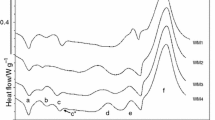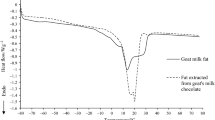Abstract
The thermal profiles of whole freeze-dried raw milk, obtained by differential scanning calorimetry (DSC) upon heating, were compared to those of their concentrate fractions (cream, skimmed milk, acid casein and whey) in order to associate the thermal peaks with the related components. Two peaks associated with fat melting, a glass transition attributed to caseins and a complex exothermic peak associated with lactose and its interactions with the other milk components were observed, in a close relation to the values of water activity of the samples. Freeze drying is the least invasive technique for drying milk, thus the results of this study may be attributed to the thermal transitions of milk components in their native state, unlike what is observed on roller- or spray-dried milk. The DSC technique is confirmed as an effective tool for the evaluation of the thermophysical properties of milk, as modified by different industrial processes.



Similar content being viewed by others
References
Murrieta-Pazos I, Gaiani C, Galet L, Cuq B, Desobry S, Scher J. Comparative study of particle structure evolution during water sorption: skim and whole milk powders. Coll Surf B Biointerfaces. 2011;87:1–10.
Ganesan V, Rosentrater KA, Muthukumarappan K. Flowability and handling characteristics of bulk solids and powders e a review with implications for DDGS. Biosyst Eng. 2008;101:425–35.
Iqbal T, Fitzpatrick JJ. Effect of storage conditions on the wall friction characteristics of three food powders. J Food Eng. 2006;72:273–80.
Schuck P, Mejean S, Dolivet A, Jeantet R, Bhandari B. Keeping quality of dairy ingredients. Lait. 2007;87:481–8.
Roos YH, Karel M. Phase transitions of mixtures of amorphous polysaccharides and sugars. Biotechnol Prog. 1990;7:159–63.
Fitzpatrick JJ, Twomey M, Cerqueira PSM, Descamps N, Roos YH (2006) Glass transition and the caking of food powders. In: CHoPS-05 conference.
Thomas MEC, Scher J, Desobry S. Lactose/β-lactoglobulin interaction during storage of model whey powders. J Dairy Sci. 2004;87:1158–66.
Thomas MEC, Scher J, Desobry-Banon S, Desobry S. Milk powders ageing: effect on physical and functional properties. Crit Rev Food Sci Nutr. 2004;44:297–322.
Szulc K, Nazarko J, Ostrowska-Ligęza E, Lenart A. Effect of fat replacement on flow and thermal properties of dairy powders. LWT–Food Sci Technol. 2016;68:653–8.
Pugliese A, Paciulli M, Chiavaro E, Mucchetti G. Characterization of commercial dried milk and some of its derivatives by differential scanning calorimetry. J Therm Anal Calorim. 2016;123:2583–90.
Cal S, Rodríguez-Puente B, Souto C, Concheiro A, Gómez-Amoza JL, Martínez-Pacheco R. Comparison of a spray-dried α-lactose monohydrate with a fully hydrated roller-dried β-lactose. Int J Pharm. 1996;136:13–21.
Rahman MS, Al-Hakmani H, Al-Alawi H, Al-Mahubi I. Thermal characteristics of freeze-dired camel milk and its major components. Thermochim Acta. 2012;549:116–23.
Vuataz G. The phase diagram of milk: a new tool for optimising the drying process. Lait. 2002;82:485–500.
Morgan F, Appolonia Nouzille C, Baechler R, Vuataz G, Raemy A. Lactose crystallisation and early Maillard reaction in skim milk powder and whey protein concentrates. Lait. 2005;85:315–23.
Jouppila K, Roos YH. Glass transitions and crystallization in milk powders. J Dairy Sci. 1994;77:2907–15.
Karel M, Lund DB. Physical principle of food preservation, vol. 137. New York: Marcel Dekker, Inc; 2003. p. 117–8.
Haque MK, Roos YH. Water plasticization and crystallization of lactose in spray-dried lactose/protein mixtures. J Food Sci Food Eng Phys Prop. 2004;69:23–9.
Wirkowska M, Ostrowska-Ligęza E, Górska A, Koczon P. Thermal properties of fats extracted from powdered baby formulas. J Therm Anal Calorim. 2012;110:137–43.
Haque MK, Roos YH. Differences in the physical state and thermal behavior of spray-dried and freeze-dried lactose and lactose/protein mixtures. Innov Food Sci Emerg Technol. 2006;7:62–73.
Chung HJ, Lim ST. Physical aging of amorphous starches (a review). Starch. 2006;58:599–610.
Haque MK. Glass transition and enthalpy relaxation of amorphous food saccharides: a review. J Agric Food Chem. 2006;54:5701–17.
Hogan SA, Famelart MH, O’Callaghan DJ, Schuck P. A novel technique for determining glass–rubber transition in dairy powders. J Food Eng. 2010;99:76–82.
Haque E, Whittaker AK, Gidley MJ, Deeth HC, Fibrianto K, Bhandari BR. Kinetics of enthalpy relaxation of milk protein concentrate powder upon ageing and its effect on solubility. Food Chem. 2012;134:1368–73.
Roos YH. Importance of glass transition and water activity to spray drying and stability of dairy powders. Lait. 2002;82:475–84.
Elzoghby AO, Helmy MW, Samy WM, Elgindy NA. Novel ionically crosslinked casein nanoparticles for flutamide delivery: formulation, characterization, and in vivo pharmacokinetics. Int J Nanomed. 2013;8:1721–32.
Bengoechea C, Arrachid A, Guerrero A, Hill SE, Mitchell JR. Relationship between the glass transition temperature and the melt flow behavior for gluten, casein and soya. J Cereal Sci. 2007;45:275–84.
Kalichevsky MT, Blanshard JMV, Tokarczuck PF. Effect of water content and sugars on the glass transition of casein and sodium caseinate. Int J Food Sci Technol. 1993;28:139–51.
Gombas A, Szabó-Révész P, Kata M, Regdon G, Erős I. Quantitative determination of crystallinity of α-lactose monohydrate by DSC. J Therm Anal Calorim. 2002;68:503–10.
Szepes A, Fiebig A, Ulrich J, Szabó-Révész P. Structural study of α-lactose monohydrate subjected to microwave irradiation. J Therm Anal Calorim. 2007;89:757–60.
Author information
Authors and Affiliations
Corresponding author
Rights and permissions
About this article
Cite this article
Pugliese, A., Paciulli, M., Chiavaro, E. et al. Application of differential scanning calorimetry to freeze-dried milk and milk fractions. J Therm Anal Calorim 137, 703–709 (2019). https://doi.org/10.1007/s10973-018-7971-7
Received:
Accepted:
Published:
Issue Date:
DOI: https://doi.org/10.1007/s10973-018-7971-7




